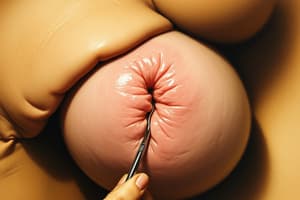Podcast
Questions and Answers
What is the main reason why leukoplakia is not diagnosed based on specific histopathological features?
What is the main reason why leukoplakia is not diagnosed based on specific histopathological features?
- Histopathologic grading (correct)
- Chronic inflammatory infiltration in lamina propria
- Varying degrees of Keratosis
- Varying degrees of epithelial thickness
According to WHO, which level of epithelial involvement corresponds to severe dysplasia?
According to WHO, which level of epithelial involvement corresponds to severe dysplasia?
- Upper (correct)
- Middle
- Lower third
- Complete epithelium
Which type of leukoplakia shows the highest rate of malignant transformation?
Which type of leukoplakia shows the highest rate of malignant transformation?
- Speckled leukoplakia (correct)
- Homogenous leukoplakia
- Non-homogenous leukoplakia
- Ventral surface leukoplakia
In the OLEP staging system, which stage indicates leukoplakia without epithelial dysplasia?
In the OLEP staging system, which stage indicates leukoplakia without epithelial dysplasia?
Which site in the oral cavity shows a higher risk of malignant transformation for leukoplakia?
Which site in the oral cavity shows a higher risk of malignant transformation for leukoplakia?
What percentage of non-homogenous leukoplakia are more dysplastic according to the text?
What percentage of non-homogenous leukoplakia are more dysplastic according to the text?
Which type of tumour is characterized by a circumscribed mass of mature adipose tissue?
Which type of tumour is characterized by a circumscribed mass of mature adipose tissue?
Where do most liposarcomas reported in the mouth typically arise?
Where do most liposarcomas reported in the mouth typically arise?
What is the characteristic color of a haemangioma?
What is the characteristic color of a haemangioma?
In what region do haemangiomas most commonly occur in the oral cavity?
In what region do haemangiomas most commonly occur in the oral cavity?
Which term best describes a hamartomatous lesion with abnormal and excessive formation of normal tissues?
Which term best describes a hamartomatous lesion with abnormal and excessive formation of normal tissues?
How do lipomas typically feel when palpated?
How do lipomas typically feel when palpated?
Which type of haemangioma is the most common in children?
Which type of haemangioma is the most common in children?
At what age do most haemangiomas tend to mostly resolve?
At what age do most haemangiomas tend to mostly resolve?
Which treatment option involves strangulation of the feeder vessel?
Which treatment option involves strangulation of the feeder vessel?
What vascular anomaly affects the veins under the oral mucosa?
What vascular anomaly affects the veins under the oral mucosa?
What type of lesion is commonly found in the mouth of patients with AIDS?
What type of lesion is commonly found in the mouth of patients with AIDS?
Which syndrome involves hemangioma of the face extending over branches of the trigeminal nerve?
Which syndrome involves hemangioma of the face extending over branches of the trigeminal nerve?
What radiographic feature is typically seen in the described jaw tumors?
What radiographic feature is typically seen in the described jaw tumors?
Which histopathologic feature is characteristic of the described tumors?
Which histopathologic feature is characteristic of the described tumors?
What distinguishes a malignant ameloblastoma from a benign ameloblastoma?
What distinguishes a malignant ameloblastoma from a benign ameloblastoma?
How does an ameloblastic carcinoma differ from a malignant ameloblastoma?
How does an ameloblastic carcinoma differ from a malignant ameloblastoma?
What does the term 'malignant ameloblastoma' mean in relation to behavior?
What does the term 'malignant ameloblastoma' mean in relation to behavior?
Which feature distinguishes an ameloblastic carcinoma from an epidermoid carcinoma?
Which feature distinguishes an ameloblastic carcinoma from an epidermoid carcinoma?
Which type of lichen planus is the most common and characterized by fine, radiant, slightly raised white striae in an interlocking lace-like pattern?
Which type of lichen planus is the most common and characterized by fine, radiant, slightly raised white striae in an interlocking lace-like pattern?
Which type of lichen planus resembles leukoplakia but is multifocal in distribution and common in smokers?
Which type of lichen planus resembles leukoplakia but is multifocal in distribution and common in smokers?
What subtype of lichen planus presents as diffuse red lesions with white striae radiating peripherally, usually found on the attached gingiva?
What subtype of lichen planus presents as diffuse red lesions with white striae radiating peripherally, usually found on the attached gingiva?
Which type of lichen planus is the second most common and is characterized by irregular lesions covered with a fibrinous plaque or a pseudomembrane?
Which type of lichen planus is the second most common and is characterized by irregular lesions covered with a fibrinous plaque or a pseudomembrane?
Which type of lichen planus has lesions that are smooth flat areas to irregular elevated areas and are common on the dorsum of the tongue?
Which type of lichen planus has lesions that are smooth flat areas to irregular elevated areas and are common on the dorsum of the tongue?
What is the prevalence range of oral lichen planus among the general population?
What is the prevalence range of oral lichen planus among the general population?
Flashcards are hidden until you start studying




